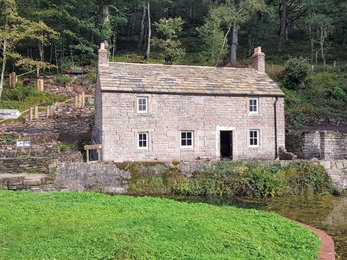It all began in the early 1960s, when a group of concerned people gathered together to oppose plans to tip fly ash at Ticknall Limeyards in South Derbyshire. Backed by national pressure, they were successful and decided to form a local charitable organisation to handle such issues. And so in 1962 Derbyshire Naturalists’ Trust was formed. Lord Hurcomb, who was the president of the Society for the Promotion of Nature Reserves at the time, saw a ring ouzel in the Goyt Valley and suggested that the bird should become the Trusts emblem and logo.
Celebrating 60 Years of Derbyshire Wildlife Trust

1962 first ever newsletter
By 1967 the Trust began to establish its first nature reserves including one at Ticknall Limeyards and a Site of Special Scientific Interest (SSSI) at Morley Brickyards, which was leased to the Trust and is home to the rare water violet. In the 1970’s the Trust acquired its first outright owned reserve in Hope Valley, Overdale, 15 hectares of upland pasture providing wonderful views and a range of diverse wildlife habitats. The Trust continued to grow its reserve list, acquiring sites at Chee Dale, Hilton and Duckmanton.
1970s Overdale
1973 the Trust appointed its first paid member of staff, Andrew Deadman as its Conservation Officer, thanks to a donation of £20,000 from Miss Mandahl who died in 1971. Six years later Pat Brassley and two further members of staff, Nick Brown (Promotions Officer) and Dian Wilson (Membership Secretary) joined the Trust.
During the 1980’s the Trust was able to campaign and lobby to protect vulnerable species and habitats more effectively. Badgers were in the limelight but not for good reasons as the debate rages about bovine tuberculosis. The Trust made the headlines when John Varty won a private prosecution against five men who were caught badger digging. It was in 1988 when the Trust changed its name to Derbyshire Wildlife Trust and added the badger as its logo which remains today!

1985 newsletter
In 1990 the Trust was able to purchase Rose End Meadows and its first visitor centre at the Whistlestop Centre in Matlock, visited by David Bellemy and Sir David Attenborough! By 1995 the Trust appointed its first Chief Executive, Irene Coope and staff members rose to eight members. Into the 2000’s the Trust had a three year lottery funded project ‘Making Natural Connections’ which enable education staff to link to schools to inspire the next generation. Huge gains for Derbyshire’s wildlife were made in the coming years, with large-scale projects in 2006 including; the Mammal Atlas project and Great Trees of Derbyshire, as well as Water for Wildlife and the Derby Cathedral’s Peregrine Project. The 500th otter was recorded in the county in the River Dove and we also took over management of Drakelow Nature Reserve, an important wetland site playing host to over 200 species of birds.

1989 Sir David Attenborough at Matlock Bath Station
By 2009 the Trust grew to 14,000 members and 500 volunteers helping the Trust support conservation in Derbyshire. In 2010 the Trust published its first ever State of Nature Report, based on more than a decade of data collected from many hundreds of Local Wildlife Sites. Another landmark was achieved in 2011, with the purchase of 200 acres of land just outside Ilkeston, which became the largest nature reserve in Derbyshire outside of the Peak District, and one of the largest urban fringe reserves in the UK.
In 2012 the Trust celebrated its 50 year anniversary with 40 members of staff! Jo Smith became the Trust’s Chief Executive in 2013 and in the same year the Trust began its badger vaccination appeal, which today has become the largest vaccination programme in the UK. The Trust also won the fight to top the destruction of The Sanctuary Local Nature Reserve in Derby. Another office move was made in 2014 to Middleton, our current office today! DerwentWISE was created, a 1.7 million pound Heritage Lottery funded project for improving wildlife habitats throughout the lower Derwent Valley, home to a ancient woodlands, pre-industrial archaeology and an industrial World Heritage Site, creating a wonderfully diverse area.
By 2016 Sue Mayer succeeded as Chair of the Trust, along with over 14,000 members! More than 20,000 of our supporters prevented the badger cull coming to Derbyshire in 2019. Following this, in 2020 the Trust purchased Thornhill Carrs Reserve, a site that is an example of rewilding at its best being managed to restore habitats and connecting landscapes for wildlife. The reserve is important for summer bird migrants when you can hear blackcap, chiff chaff and willow warbler taking advantage of this ever rarer habitat.

(c) Tim Birch / Thornhill Carrs 2020
Last year in 2021 we celebrated the reintroduction of beavers back into Derbyshire for the first time in 800 years! Four beavers were released at Willington Wetlands, in hope to have an impact on the site creating diverse wetland areas and homes for other wildlife.
We start 2022 with 18,000 valued members! We’re focusing on ambitious goals, 33% of Derbyshire to be managed for wildlife by 2030, more people to notice and care through our community engagement and 1 in 4 people to act for wildlife through our Team Wilder initiative. We are also beginning to move away from reserves to full scale landscape recovery so wildlife can move freely in Derbyshire.
We are looking forward to achieving so much for wildlife here in Derbyshire. Here’s to the next 60 years!






